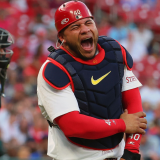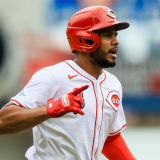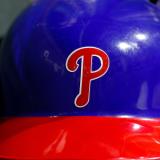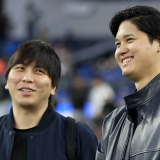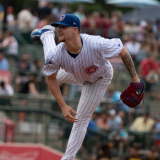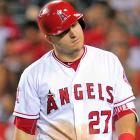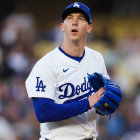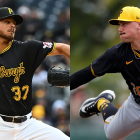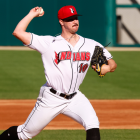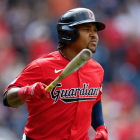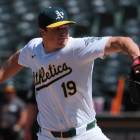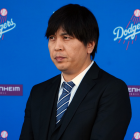On Saturday, 37,264 fans streamed into Citi Field to watch the Mets host the Angels. At first glance, this was an unremarkable game, with two sub-.500 teams matching up on a comfortable spring evening. What the crowd didn't know was that they were witnessing a slice of history.
Mike Trout has been the best player in baseball since his first full season of 2012. His teammates have grown progressively worse. The result, as it was on Saturday, is one of the most lopsided lineups the game has ever seen. The greatest player of his generation -- a player who so far has been the statistical twin of Willie Mays -- is playing with a bunch of minor-leaguers.
Trout the two-time MVP batted third against the Mets Saturday night, coming into that game with a huge .741 slugging percentage. The next-best slugging mark in that lineup? The .341 mark turned in by No. 2 hitter Kole Calhoun.
Cherry-picking Saturday's lineup is a bit of a cheat, since Albert Pujols sat that night with a hamstring injury. Still, the Angels' second-highest paid player and the man signed to a 10-year deal to be Trout's wingman looks like he's on his last legs, literally and figuratively. Ignore Pujols' lofty RBI total (an inanimate carbon rod could knock in 90 runs hitting behind Trout) and you get a replacement-level hitter: .242/.292/.364 for a player with zero defensive value.
We know that Trout is incredible. We know that his eight lineup mates on any given night are awful. But how does the Angels' star-and-scrubs lineup compare to others from baseball's past?
For the answer, we turned to Fangraphs researcher Jonah Pemstein (no relation). Pemstein looked at All-Star player vs. rest of team comparisons going back to 1955, the earliest year in Fangraphs' database in which the park-adjusted, catch-all offensive stat Weighted Runs Created Plus (wRC+) can be accurately calculated using available components.
Not surprisingly, the top three entrants on this list are all Barry Bonds' Giants teams, because Barry Bonds was the best hitter any of us will see in our lifetimes. Ted Williams and the 1957 Red Sox check in at No. 4. At No. 5? Mike Trout and his 2017 Lilliputian teammates.
| Name | Season | Team | Player's wRC | Rest of team wRC | Difference |
| Barry Bonds | 2002 | SFG | 244 | 92 | 152 |
| Barry Bonds | 2004 | SFG | 233 | 89 | 144 |
| Barry Bonds | 2001 | SFG | 235 | 92 | 143 |
| Ted Williams | 1957 | BOS | 223 | 83 | 140 |
| Mike Trout | 2017 | LAA | 217 | 81 | 136 |
| Mickey Mantle | 1957 | NYY | 217 | 93 | 124 |
| Barry Bonds | 2003 | SFG | 212 | 90 | 123 |
| Manny Ramirez | 2008 | LAD | 210 | 89 | 121 |
| Dick Allen | 1972 | CHW | 199 | 80 | 118 |
| Bryce Harper | 2015 | WSN | 197 | 84 | 114 |
This is what happens when, other than Trout, you whiff so badly for years on drafting and developing hitting prospects. Check out the Angels' history of first-round picks and you get 20 years of ugliness. Since hitting on back-to-back great first-rounders in Darin Erstad (1995) and Troy Glaus (1997), the Angels have landed just one first-round position player who's made significant contributions in an Angels uniform. That one player? Mike Trout.
Sift through those picks and some patterns emerge, and that's even after putting aside the pitcher picks of the past two decades (which likewise haven't produced any notable major league success stories other than Jered Weaver). For one thing, impetuous owner Arte Moreno has championed several big-ticket free-agent signings (most notably Pujols) which have torpedoed the team's payroll and also cost the Halos first-round picks; they forfeited their first-rounders in 2005, 2007, 2008, 2012, and 2013.
Even more damning, though, is what's happened on the rare occasions when the Angels actually landed on promising hitters not named Trout. In 2009, they drafted Texas high-school outfielder Randal Grichuk in the first round, 24th overall. Four years later, in an attempt to add win-now veteran help, the Angels flipped Grichuk and outfielder Peter Bourjos for third baseman David Freese and reliever Fernando Salas. Freese was a competent starter in Anaheim for two years, while Salas didn't help much. Meanwhile Grichuk cracked the big leagues the very next spring, became a three-win player upon claiming a full-time role in 2015, and remains under Cardinals' control through 2020, still making league minimum as a pre-arbitration player this year.
Then there's the case of Mike Napoli. A 17th-round pick in the 2000 draft, Napoli has never done anything but mash. From the moment he debuted in the majors in 2006, he was one of the most potent offensive catchers in the game. And Mike Scioscia hated him. The Angels at the time employed great-glove, no-hit catcher Jeff Mathis too. Being an old-school curmudgeon of an ex-catcher, Scioscia decided Mathis had to play and ground out to second four times a game, and Napoli could have whatever playing time scraps remained. Napoli did eventually get more reps, playing 140 games in 2010, blasting a career-best 26 homers that year. The Angels' reaction? One of the worst trades in baseball history, a 2-for-1 deal that sent Napoli and outfielder Juan Rivera out of town, in exchange for Vernon Wells, whose multi-year deal became one of the biggest boondoggle contracts of all time.
(If you want to be picky, Mark Trumbo might offer an exception. The Angels stole him as an 18th-round pick in 2004. He finished second in Rookie of the Year voting in 2011, then made the All-Star team the next year with the Angels. They then flipped him in a three-way deal with the White Sox and Diamondbacks after the 2013 season, netting left-handers Hector Santiago and Tyler Skaggs in return. Though even then, the best player in the trade, Adam Eaton, ended up in Chicago, not Anaheim. Also, Casey Kotchman doesn't count.)
The combination of Moreno's impulsiveness, Scioscia's stubbornness, and plain old bad drafting and player development now has the Angels in a huge bind. They employ a player who in less than six seasons of work has already surpassed the resumes of many Hall of Famers. They also employ one of the worst supporting casts in baseball, leaving them with a slim chance of making the playoffs, much less competing for a World Series title. Not this year, not next year, and maybe not for a few more years, unless the Angels catch a series of really lucky breaks.
The implication from all this is obvious: The Angels should trade Trout. He's signed through 2020 and remains an incredible bargain, even at $33.25 million a year from 2018 through 2020. But if the Halos can't piece together an even half-competent lineup around Trout between now and then, there won't be much glory in winning 78-82 games every year. Which is a damn shame, considering the things that Trout makes even his fellow MLB stars say:
Joey Votto on stacking up against Mike Trout: pic.twitter.com/SLXV4n9MR2
— Zach Buchanan (@ZachENQ) October 2, 2016
But here's the thing: A trade is almost certainly not going to happen. Moreno has said on multiple occasions that he won't do so. Words aside, the superstar-hungry owner who pushed to sign Pujols until age 87 isn't suddenly going to embrace the idea of trading a modern-day Mays in his mid-to-late 20s.
Moreover, it's not clear that any owner would make that move. No matter how analytical and pragmatic a given team might be, trading a fading veteran for prospects is not the same thing as trading a guy in his prime who'll have statues built in his honor when he eventually retires. That goes double for any franchise that has no other significant drawing card to offer to fans.
So the status quo will remain. Over the next few years, Trout's going to take aim at some of the biggest legends we've ever known. He's going to do so wearing an Angels uniform. And, unless something drastic suddenly changes, he's likely to do so on some mediocre to very bad teams.








